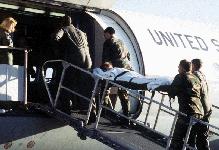Are they using them to Evac the seriously ill from the N.O. Airport? Do these have, or could they equip them with, Kidney Dialysis machines and other needed machines the "don't have" at the N.O. Airport?
If they have they been using them, I've not seen them or heard the "news" talk about them. These jets are specifically made for medical evac when a safe Airport runway is available.
So, WTF? anyone seen these being used, or they all up in Illinois getting washed.:wtf:




Here's the description from this web page:
<
http://www.fas.org/man/dod-101/sys/ac/c-9.htm>
C-9A/C Nightingale
The C-9 is a twin-engine, T-tailed, medium-range, swept-wing jet aircraft used primarily for Air Mobility Command's aeromedical evacuation mission. The Nightingale is a modified version of the McDonnell Douglas Aircraft Corporation's DC-9. It is the only aircraft in the inventory specifically designed for the movement of litter and ambulatory patients.
The C-9A's airlift capability to carry 40 litter patients, 40 ambulatory and four litter patients, or various combinations thereof, provides the flexibility for Air Mobility Command's worldwide aeromedical evacuation role. A hydraulically operated folding ramp allows efficient loading and unloading of litter patients and special medical equipment.
The plane has:
* Ceiling receptacles for securing intravenous bottles.
* A special care area with a separate ventilation system for patients requiring isolation or intensive care.
* Eleven vacuum and therapeutic oxygen outlets, positioned in sidewall service panels at litter tier locations.
* A 28 VDC outlet in the special care area.
* Twenty-two 115 VAC-60 hertz electrical outlets located throughout the cabin permit the use of cardiac monitors, respirators, incubators and infusion pumps at any location within the cabin.
* A medical refrigerator for preserving whole blood and biological drugs.
* A medical supply work area with sink, medicine storage section and work table, fore-and-aft galleys and lavatories.
* Aft-facing commercial airline-type seats for ambulatory patients.
* A station for a medical crew director that includes a desk communication panel and a control panel to monitor cabin temperature, therapeutic oxygen and vacuum system.
* An auxiliary power unit that provides electrical power for uninterrupted cabin air conditioning, quick servicing during stops, and self-starting for the twin-jet engines.
The 375th Airlift Wing at Scott Air Force Base, Ill.